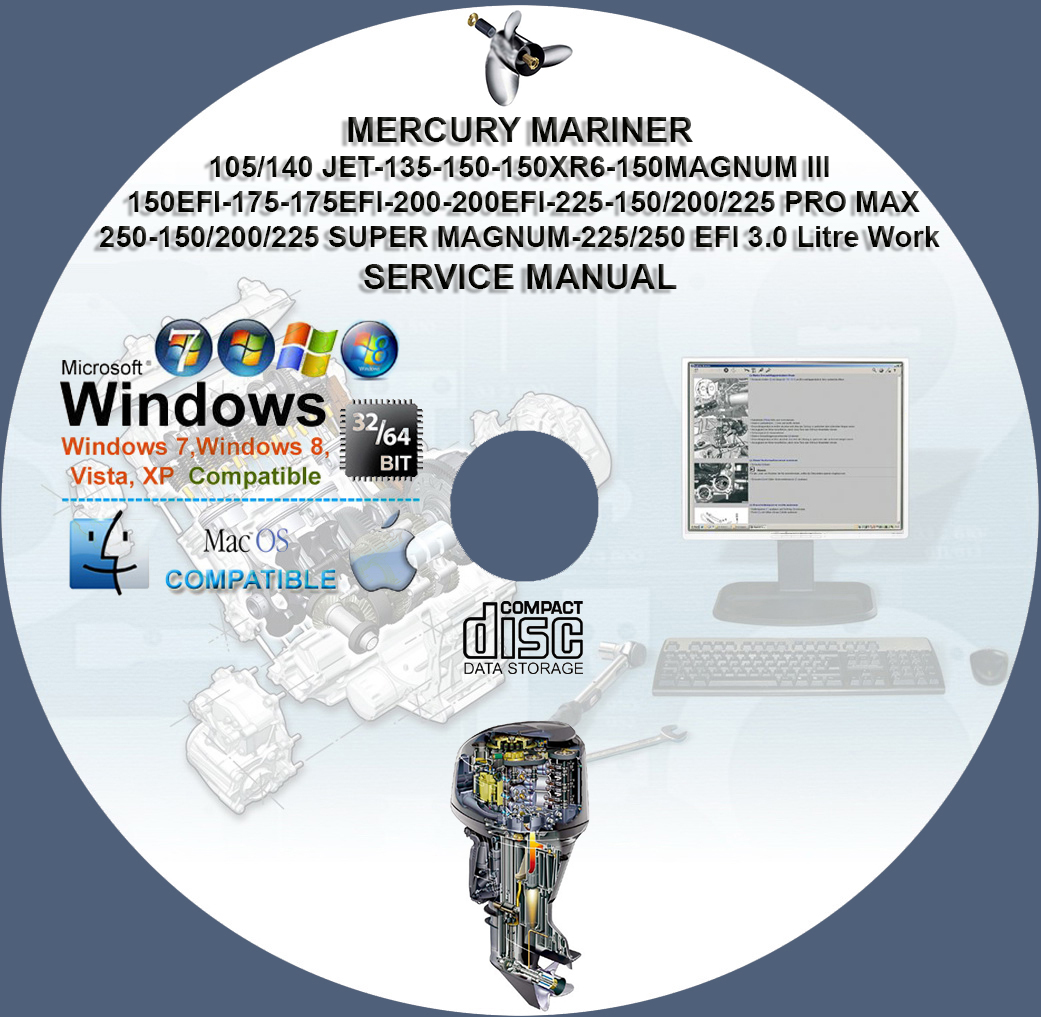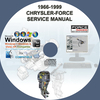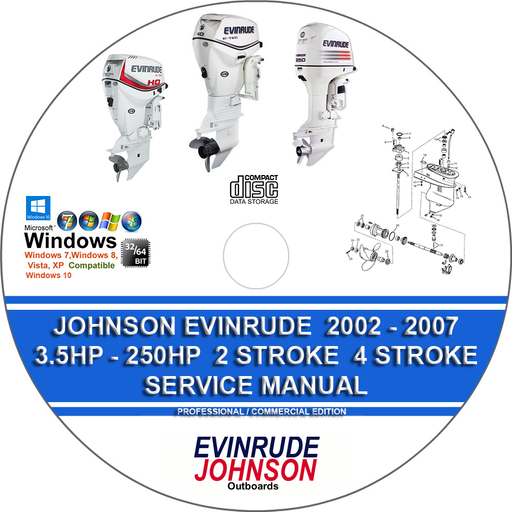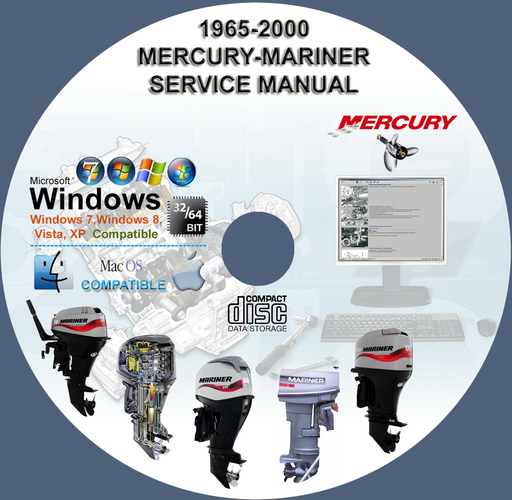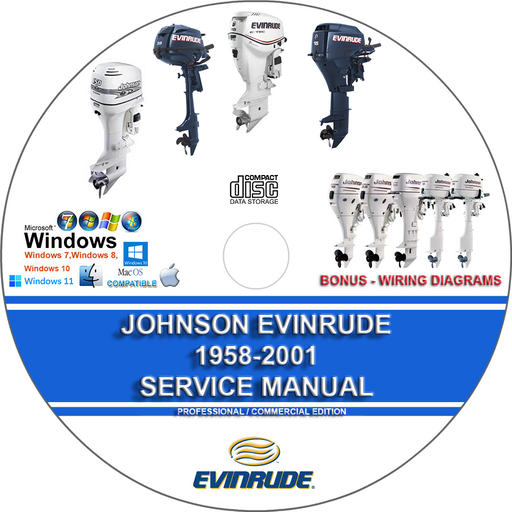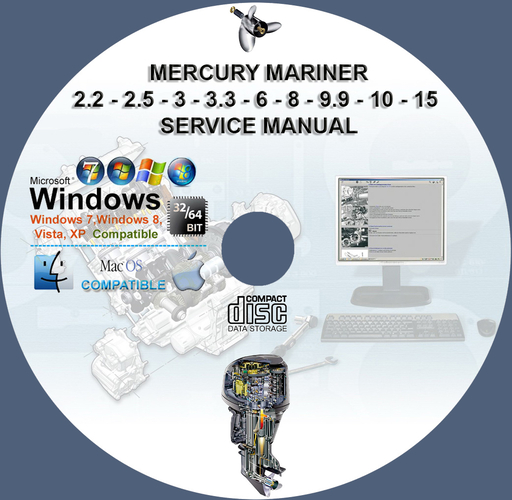Mercury Two stroke 105 140 JET 135 150 175 200 225 250 Mariner Factory Service Repair Manual + Wirings
$39.00 – $48.00Price range: $39.00 through $48.00
Mercury Two stroke 105 140 JET 135 150 175 200 225 250 Mariner Factory Service Repair Manual + Wirings
You can download this or I can ship it to you.
Loaded with Hi Resolution illustrations, instructions, photos, and diagrams, complete to service and repair your MERCURY.
Thousands of Pages
Mercury Two stroke 105 140 JET 135 150 175 200 225 250 Mariner Factory Service Repair Manual + Wirings
Loaded with illustrations, instructions, photos, and diagrams, complete to service and repair your Mercury.
Thousands of Pages
Models Covered :
- 105/140 JET
- 135
- 150
- 150 XR6
- 150 MAGNUM III
- 150 EFI
- 175
- 175 EFI
- 200
- 200 EFI
- 150/200/225 PRO MAX
- 150/200/225 SUPER MAGNUM
- 225/250 EFI 3.0 Liter Work
With Serial Numbers:
0D082000 Through 0G960499
0D082000 Through 0T105314
0D082000 and Above
0G960500 and Above
0T409000 and Above – Starting 2002
Year:
1992-2000
Manual Covers :
Information:
- Specifications
- Maintenance
- General Information
- Outboard Installation
Electrical:
- Ignition
- Charging and Starting System
- Timing, Synchronizing and Adjusting
- Wiring Diagrams
Fuel System:
- Fuel Pump
- Carburetor
- Fuel Injection1995-Prior
- Fuel Injection 1996 and Up
- Oil Injection
- Emissions
Powerhead:
- Powerhead
- Cooling
Mid-Section:
- Clamp/Swivel Brackets and Drive Shaft Housing
- Power Trim
Lower Unit:
- Right Hand Rotation
- Left Hand Rotation
- 78:1 Ratio (4-1/4” Dia)
- Right Hand Non-Ratcheting
- Left Hand Non-Ratcheting
- Jet Outboards
Attachments/Control Linkage
This manual is the same as the manual used by workshops. Service Manual contains detailed instructions and step by step diagrams for all workshop procedures.
Language: English
Format: PDF – Indexed and Searchable
COMPATIBLE WITH ALL WINDOWS & MAC COMPUTERS
(WINDOWS 11, WINDOWS 10, WINDOWS 8 ETC.)
Windows/Mac/Tablet/Phone Friendly
- Performance: They offer high maneuverability in situations where a propeller would be damaged.
- Characteristics: The jet drive results in a slight horsepower loss compared to a prop-driven counterpart but provides specialized performance for rivers and other shallow areas.
- Early models (pre-mid-1990s): Most were carbureted and came in displacements like 2.0L, 2.4L, and 2.5L. Performance models included the Black Max series and XR-series with enhanced features.
- EFI and Optimax (mid-1990s and later): In the mid-1990s, Mercury introduced Electronic Fuel Injection (EFI) for better fuel efficiency and throttle response. This was followed by the Optimax line, which used Direct Fuel Injection (DFI) to improve fuel economy and lower emissions significantly
.
- High-performance versions: The Pro Max, Super Magnum, and later XS models (Optimax) offered high-performance features like revised porting, special pistons, and different engine control module (PCM) calibration for competitive use.
- 135, 150, 175 HP: These typically used the 2.5L V6 block, with the different horsepower ratings achieved through carburetor size or EFI programming. For example, a 150 HP XR6 had different tuning than a standard 150 HP.
- 200, 225, 250 HP: These used both 2.5L and 3.0L blocks over time. The larger displacement allowed for more power, especially at lower RPMs. In the Optimax line, the 250 HP might have different pistons, heads, and a higher air/fuel pressure than the 200 or 225
.
- Mariner vs. Mercury: A Mariner 225 EFI from 1996 would be mechanically identical to a Mercury 225 EFI from the same year, with parts often being interchangeable.
- Optimax fuel system: Owners of Optimax models must be diligent with fuel filter changes and fuel system checks. The DFI system is more complex and requires clean fuel to function correctly.
- Powerhead issues: While generally reliable, older engines can experience wear on pistons, rings, and crank seals. Any decrease in performance or unusual engine noise warrants an inspection.
- Trim motor
: Aftermarket trim motors are commonly available for these models.
- Water pump impeller: Given the age of these engines, the water pump impeller should be inspected and replaced regularly to prevent overheating.
| Medium | USB Flash Drive, DVD, Download |
|---|
Related products
Watercrafts/Boats
Watercrafts/Boats
Watercrafts/Boats
Johnson Evinrude
Watercrafts/Boats
Watercrafts/Boats
Mercury Two stroke 2.2 2.5 3 3.3 6 8 9.9 10 15 Mariner Factory Service Repair Manual + Wirings
Johnson Evinrude
Johnson Evinrude Outboard 1998 1999 2000 2001 1-300 HP Factory Service Repair Manual

